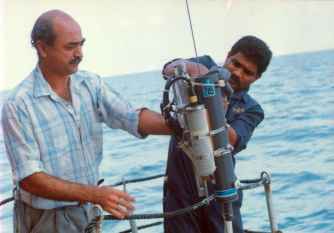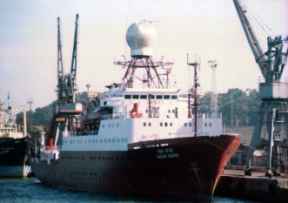geotimesheader
News Notes
Global change
Laughing
gas throws a hard punch
A shocking amount of nitrous oxide off the
western coast of India is causing scientists to take another look at laughing
gas. Researchers at the National Institute of Oceanography in Goa found
three times more nitrous oxide in the Arabian Sea than previously found
anywhere else in the world.
“The actual magnitude of the concentrations really blew me away,” says
Louis Codispoti of Horn Point Laboratory in Cambridge, Md., who read the
report in the Nov. 16 Nature. The findings also suggest nitrous
oxide plays a stronger role in global warming than originally thought.
 “We
are talking about a fairly large and globally significant source,” says
Wajih Naqvi, the primary author of the report. The contribution of the
Arabian Sea to the total amount of nitrous oxide into the atmosphere may
be as much as one million tons per year or 25 percent of all anthropogenic
sources of nitrous oxide, he says. This complicates the picture of global
warming even further. “On a per molecule basis, nitrous oxide is over 200
times more effective in absorbing infrared radiation as carbon dioxide.”
Even small increases in nitrous oxide inventory of the atmosphere could
bring about relatively large changes in climate.
“We
are talking about a fairly large and globally significant source,” says
Wajih Naqvi, the primary author of the report. The contribution of the
Arabian Sea to the total amount of nitrous oxide into the atmosphere may
be as much as one million tons per year or 25 percent of all anthropogenic
sources of nitrous oxide, he says. This complicates the picture of global
warming even further. “On a per molecule basis, nitrous oxide is over 200
times more effective in absorbing infrared radiation as carbon dioxide.”
Even small increases in nitrous oxide inventory of the atmosphere could
bring about relatively large changes in climate.
[Wajih Naqvi (left) and
assistant prepare a water trap while on board the Research Vessel Sagar
Kanya (below right). Photos courtesy of W. Naqvi.]
A 1992 report of nitrous oxide concentrations of 173 nanomoles off the
coast of Peru held the record. Naqvi’s report, with nitrous oxide concentrations
reaching 533 nanomoles in the Arabian Sea, triples that number. During
the summer monsoon season, an undercurrent off the coastal shelf of western
India brings an upwelling of cold, saline, nutrient rich and oxygen depleted
water to the country’s shores. But freshwater runoff during the heavy monsoon
rains bleeds out over the colder seawater — covering it with a 5- to 10-meter-thick,
warm cap. Planktonic algae thrive in the upper layers of these nutrient
rich waters before sinking to the bottom where bacteria, living off decaying
organic matter, produce nitrous oxide in the low-oxygen environment through
both nitrification and denitrification.

The three-year study also indicates fertilizer runoff into the Arabian
Sea may be contributing to the production of the nitrous oxide. The increasing
runoff of nutrients from land aggravate the situation by increasing eutrophication
in the surface waters and thereby feeding the bacteria with further organic
matter. Because the area is so shallow, 6 to 28 meters, the nitrous oxide
produced can easily escape to the atmosphere, Naqvi says. More nitrous
oxide could feed a vicious cycle — leading to increased global warming,
potentially stronger monsoons, an increase in the nitrogen-laden runoff
from land, coastal eutrophication, and bacteria producing nitrous oxide
as they munch on dead plankton cells. And nitrous oxide is but one part
in the “deliciously complex” nitrogen cycle, Codispoti says.
In the open ocean, the site of past studies on nitrous oxide, scientists
such as Codispoti learned that bacteria finish eating what little oxygen
remains in their surroundings and then begin to consume the nitrous oxide
they already produced — converting N2O to N2 using an enzyme known as nitrous
oxide reductase in the denitrification process. The bacteria switch to
consuming the reductase — helping to keep the level of nitrous oxide in
check.
Naqvi and colleagues have found that in shallow waters with almost no
oxygen, high microbial metabolic rates can lead to brief periods when nitrous
oxide accumulates to extremely high levels with the chance, in the shallow
environment, to escape before the bacteria can chow down on the nitrous
oxide reductase. This can give a pulsing effect to the levels of nitrous
oxide as the stop-and-go nature of local phenomena, such as storms, temporarily
re-oxygenate the waters.
“It’s time we started looking at analogous areas more closely,” Codispoti
says. He would like to investigate nitrous oxide in the Chesapeake Bay.
Other areas with fluctuating nutrient zones to explore include the mouth
of the Mississippi River, the Gulf of Mexico and coastal waters off Peru.
Christina Reed
 “We
are talking about a fairly large and globally significant source,” says
Wajih Naqvi, the primary author of the report. The contribution of the
Arabian Sea to the total amount of nitrous oxide into the atmosphere may
be as much as one million tons per year or 25 percent of all anthropogenic
sources of nitrous oxide, he says. This complicates the picture of global
warming even further. “On a per molecule basis, nitrous oxide is over 200
times more effective in absorbing infrared radiation as carbon dioxide.”
Even small increases in nitrous oxide inventory of the atmosphere could
bring about relatively large changes in climate.
“We
are talking about a fairly large and globally significant source,” says
Wajih Naqvi, the primary author of the report. The contribution of the
Arabian Sea to the total amount of nitrous oxide into the atmosphere may
be as much as one million tons per year or 25 percent of all anthropogenic
sources of nitrous oxide, he says. This complicates the picture of global
warming even further. “On a per molecule basis, nitrous oxide is over 200
times more effective in absorbing infrared radiation as carbon dioxide.”
Even small increases in nitrous oxide inventory of the atmosphere could
bring about relatively large changes in climate.

